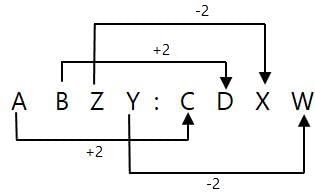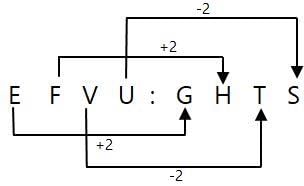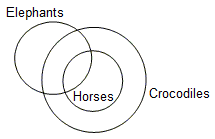UGC NET Paper 1 Practice Test - 9 - UGC NET MCQ
30 Questions MCQ Test UGC NET Mock Test Series 2025 - UGC NET Paper 1 Practice Test - 9
Direction: Choose the correct option with the help of Assertion (A) and Reason (R).
Assertion (A): The initial messages to students in the classroom by a teacher need not be critical to establishing interactions later.
Reason (R): More control over the communication process means more control over what the students are learning.
Assertion (A): The initial messages to students in the classroom by a teacher need not be critical to establishing interactions later.
Reason (R): More control over the communication process means more control over what the students are learning.
Which of the following set of statements reflects the basic characteristics of teaching?
(A) Teaching is related to learning.
(B) Teaching is a ‘task’ word while learning is an ‘achievement’ word.
(C) One may teach without learning taking place.
Nowadays, the most effective mode of learning is
Find the number of triangles in the given figure?

Which of the following is a scaled down teaching situation?
Direction: In the following question, select the related word/letters/numbers from the given alternatives.
ABZY : CDXW : : EFVU : ?
On the first day of his class, if a teacher is asked by the students to introduce himself, he should
Under Sustainable Development Goal 3 - 'Good Health and Wellbeing', by 2030, the premature mortality from non-communicable diseases is to be reduced by:
Directions: Read the following passage carefully and answer the following question.
All historians are interpreters of text if they be private letters, Government records or parish birthlists or whatever. For most kinds of historians, these are only the necessary means to understanding something other than the texts themselves, such as a political action or a historical trend, whereas for the intellectual historian, a full understanding of his chosen texts is itself the aim of his enquiries. Of course, the intellectual history is particularly prone to draw on the focus of other disciplines that are habitually interpreting texts for purposes of their own, probing the reasoning that ostensibly connects premises and conclusions. Furthermore, the boundaries with adjacent subdisciplines are shifting and indistinct, the history of art and science both claim a certain autonomy, partly just because they require specialised technical skills. Both can also be seen as part of a wider intellectual history, as is evident when one considers. For example, the common stock of knowledge about cosmological beliefs or moral ideals of a period.
Like all historians, the intellectual historian is a consumer rather than a producer of ‘methods’. His distinctiveness lies in which aspect of the past he is trying to illuminate, not in having exclusive possession of either a corpus of evidence or a body of techniques. That being said, it does seem that the label ‘intellectual history’ attracts a disproportionate share of misunderstanding.
It is alleged that intellectual history is the history of something that never really mattered. The long dominance of the historical profession by political historians bred a kind of philistinism, an unspoken belief that power and its exercise was ‘what mattered’. The prejudice was reinforced by the assertion that political action was never really the outcome of principles or ideas that were ‘more flapdoodle’. The legacy of this precept is still discernible in the tendency to require ideas to have ‘licensed’ the political class before they can be deemed worthy of intellectual attention, as if there were some reasons why the history of art or science, of philosophy or literature, were somehow of interest and significance than the history of Parties or Parliaments. Perhaps in recent years, the mirror-image of this philistinism has been more common in the claim that ideas of any one systematic expression or sophistication do not matter, as if they were only held by a minority.
Q. Intellectual historians do not claim exclusive possession of
Directions: Read the following passage carefully and answer the following question.
All historians are interpreters of text if they be private letters, Government records or parish birthlists or whatever. For most kinds of historians, these are only the necessary means to understanding something other than the texts themselves, such as a political action or a historical trend, whereas for the intellectual historian, a full understanding of his chosen texts is itself the aim of his enquiries. Of course, the intellectual history is particularly prone to draw on the focus of other disciplines that are habitually interpreting texts for purposes of their own, probing the reasoning that ostensibly connects premises and conclusions. Furthermore, the boundaries with adjacent subdisciplines are shifting and indistinct, the history of art and science both claim a certain autonomy, partly just because they require specialised technical skills. Both can also be seen as part of a wider intellectual history, as is evident when one considers. For example, the common stock of knowledge about cosmological beliefs or moral ideals of a period.
Like all historians, the intellectual historian is a consumer rather than a producer of ‘methods’. His distinctiveness lies in which aspect of the past he is trying to illuminate, not in having exclusive possession of either a corpus of evidence or a body of techniques. That being said, it does seem that the label ‘intellectual history’ attracts a disproportionate share of misunderstanding.
It is alleged that intellectual history is the history of something that never really mattered. The long dominance of the historical profession by political historians bred a kind of philistinism, an unspoken belief that power and its exercise was ‘what mattered’. The prejudice was reinforced by the assertion that political action was never really the outcome of principles or ideas that were ‘more flapdoodle’. The legacy of this precept is still discernible in the tendency to require ideas to have ‘licensed’ the political class before they can be deemed worthy of intellectual attention, as if there were some reasons why the history of art or science, of philosophy or literature, were somehow of interest and significance than the history of Parties or Parliaments. Perhaps in recent years, the mirror-image of this philistinism has been more common in the claim that ideas of any one systematic expression or sophistication do not matter, as if they were only held by a minority.
Q. What is philistinism?
Direction: Study the following table chart carefully and answer the question given beside.
The following table represents the Maximum marks of five subjects and marks obtained by five students in five subjects.
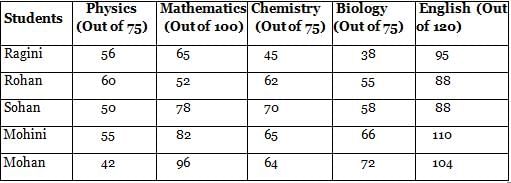
Q. Marks obtained by Ragini in Chemistry and Biology together is what percent of the marks obtained by Mohini in Physics and Mathematics together?
Direction: Study the following table chart carefully and answer the question given beside.
The following table represents the Maximum marks of five subjects and marks obtained by five students in five subjects.
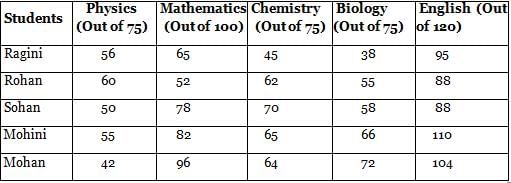
Q. Find the respective ratio of the marks obtained by all the students in Mathematics and marks obtained by all the students in Chemistry.
Direction: Study the following table chart carefully and answer the question given beside.
The following table represents the Maximum marks of five subjects and marks obtained by five students in five subjects.
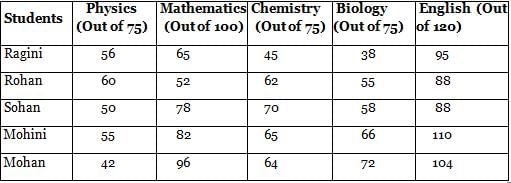
Q. Find the overall percentage of Sohan in all the subjects.
The newspapers have the highest circulation in India
The modern system of higher education in India can be traced back to 1857 with the establishment of universities at:
A. Bombay
B. Calcutta
C. New Delhi
D. Bangalore
E. Madras
Choose the correct answer from the options given below:
Communication issues at the international level are addressed by
The educational institutions, libraries, hospitals, and industries store the concerned:
(A) Operating system
(B) Word processing
(C) Data management
(D) Informing system
Transforming thoughts, ideas and messages into verbal and non-verbal signs is referred to as
Which one of the following is a non-probability sampling?
Directions: In the following question, there are two statements followed by two conclusions I and II. You are to take the two statements to be true even if they seem to be at variance from the commonly known facts and then decide which of the conclusions logically follow(s) from the two statements.
Statements:
Some elephants are horses.
All horses are crocodiles.
Conclusions:
I. No crocodile is an elephant.
II. Some elephants are crocodiles.
Which of the following learner characteristics are likely to influence the effectiveness of teaching aids and evaluation systems to ensure positive results?
(A) Learner’s family background, age and habitation
(B) Learner’s parentage, socio-economic background and performance in learning of the concerned subject
(C) Learner’s stage of development, social background and personal interests
(D) Learner’s maturity level, academic performance level and motivational dispositions
If the salary of a person was first increased by 10% and later, the same was reduced by 10%, then the net change in his salary is
______ is the most important characteristic of a good teacher.
Which of the following diagrams indicates the best relation among dogs, cats and horses?
Anil's participation in classroom is indifferent. His parents do not find him to be active either. But his performance in examinations, ranges from being good to outstanding. Therefore, he must be studying privately, in a clandestine way. This is an example of which kind of Pramana?
'God is great because He does great things'. This inference commits which kind of fallacy?
Which of these should be avoided for an effective speech?
|
92 docs|125 tests
|




